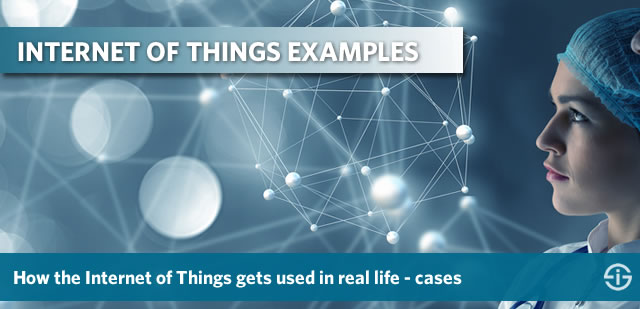The best way for organizations to look at the potential of IoT deployments to succeed in their digital transformation efforts, optimize their efficiency and better serve their customers is by understanding the business rationale behind IoT examples in real life.
Add to that the several potential use cases (areas where IoT is and can be deployed such as manufacturing operations, precision farming, smart lighting, smart buildings and so forth), an understanding of the essence of the Internet of Things and its applications, a good mix of common business sense, sound advice, and lessons from success stories, and the Internet of Things becomes tangible instead of just a term and set of technologies.

IoT examples: what and why
IoT examples, such as the ones in the list below, are examples of IoT projects (or projects in which IoT technologies were essential as obviously other technologies are required to enable them) realized by individuals and organizations in multiple areas.
Such IoT projects and real-life examples can be specific to an industry or to the type of solution. IoT use cases are not real examples of projects. They are categories of applications that are possible by leveraging IoT technologies.
Some IoT use cases are typical for one industry. Take precision farming, which we mentioned in the beginning. Within that scope, crop management, for instance, would typically be a use case in agriculture. Some environmental monitoring use cases are used in agriculture but can also be used elsewhere. Or take smart lighting and others mentioned earlier.
In Industrial IoT take the example of predictive maintenance: it can be used in manufacturing, oil and gas, building management and so on. But other IIoT use cases could be limited to one industry or domain while some use cases can both be used by consumers and industries. An example: asset tracking, it just depends on what the asset is. Confusing? Never mind. There is no such thing as a universally agreed set of IoT use cases but you might hear people speak about industry-specific and cross-industry IoT use cases. IDC, for instance, used to make forecasts on the evolution of IoT by using these two essential types of use cases.
Examples of industry-specific use cases in the IDC classification: manufacturing operations (manufacturing indeed), smart buildings and smart grid. But, within some of these areas, you can often find more types of – potential IoT – applications which use cases in the end are. Since the beginning of IoT many firms have started to track the number of projects per use cases and many also have advice regarding, for instance, the connectivity standards to use. But, as you can imagine, the views differ per vendor, the names of use cases differ and the ways they are categorized as well, which is a bit of a pity since in the end IoT projects are realizations of use cases.
Look for the business drivers in IoT examples
Good and effective IoT examples start with challenges and/or end goals in mind. While looking at the ways to achieve these end goals, new opportunities often arise. In most cases these revolve around tapping into new revenues, mainly customer-facing and often collaborative, in an ‘as a service economy’.
There are ample of IoT examples across various industries. Some are pilot projects, others are fully operational, scalable and driving business and customer value. From Industrial IoT cases in Industry 4.0 and examples in transportation and logistics (Logistics 4.0) and utilities to consumer IoT, healthcare IoT, retail, smart city applications and cross-industry IoT use cases: there are always practical real-life IoT examples out there and they keep increasing.
As the Internet of Things, from an actual usage perspective, is part of a bigger picture and derives its value from the challenges and end goals it’s clear that not all industries are moving at the same speed. This means that in some industries you’ll find more IoT examples.
However, the essence of scalable IoT deployments, from the business and outcome perspective, knows no industry borders. The challenges and chances are often pretty universal. In the end, we talk about offering better customer service, tapping into new sources of data, insights and actionable intelligence, innovation, productivity enhancement and myriad other goals that are common across sectors.
In other words: when you look for examples of Internet of Things deployments that work or are in a pilot stage, certainly don’t limit your quest to examples from your industry. The customer is one and has similar expectations, regardless of industry. Business challenges and opportunities are more diverse but still: there is always something to be learned.
List of IoT examples
As the focus of this website is to inform and educate on marketing, transformation, customer experience, information management, technology and IT in a context of business and people, we now and then cover some IoT examples and case studies, applications/types of IoT use cases in practice.
You can check some out below. They are mainly based on publicly available cases with the necessary additional information and analysis. Do bear in mind that case studies are made by companies so we try to focus on the essence, based upon various mentioned sources.






